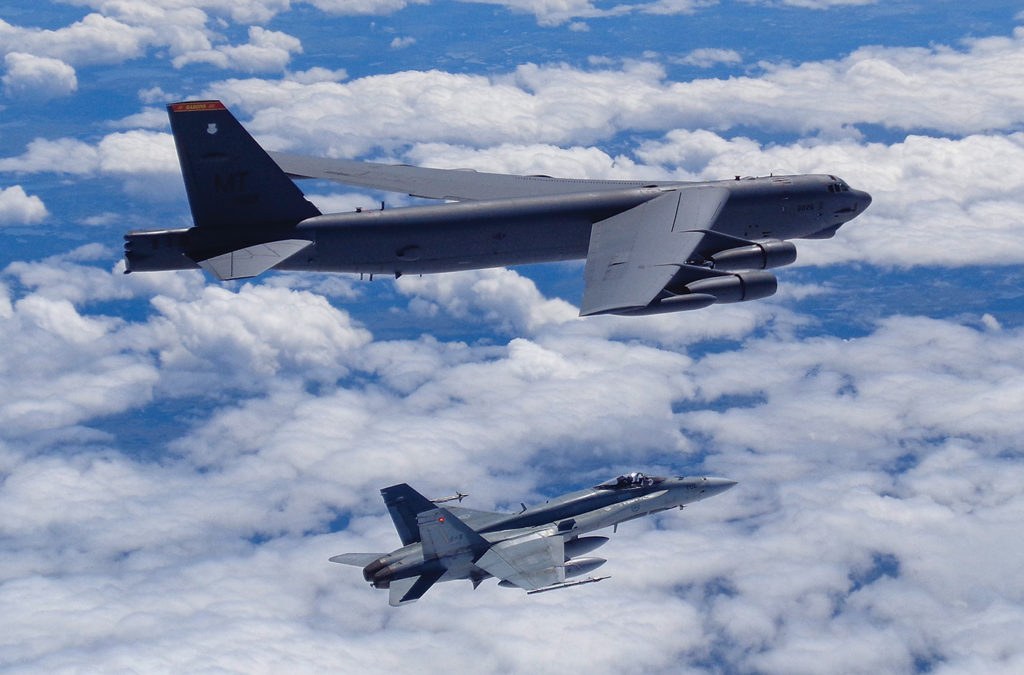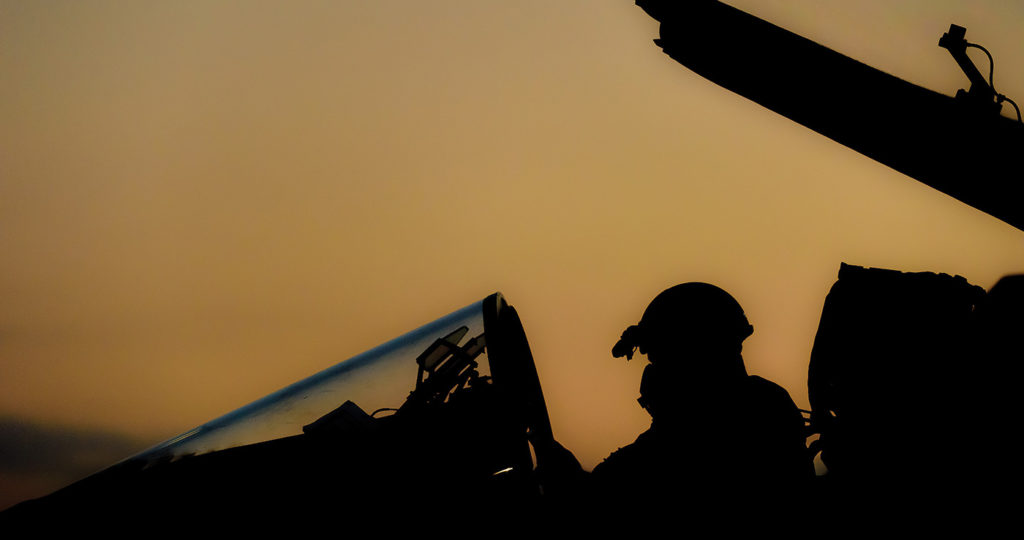Estimated reading time 5 minutes, 49 seconds.
What does it take to man the Q, more formally known to CF-188 Hornet pilots as the NORAD quick reaction alert? Lots of coffee.

It is probably the most important mission of the Royal Canadian Air Force (RCAF), defending and deterring threats from Canadian sovereign airspace. Though much of how it is conducted is highly classified, pilots and support personnel from 401 Tactical Fighter Squadron (TFS) were willing to share a little about a typical day in the Q that involves copious amounts of coffee and most describe as the epitome of hurry up and wait.
The RCAF’s four fighter squadrons alternate the responsibility from various locations across Canada, including their main operating bases at 4 Wing Cold Lake, Alta., and 3 Wing Bagotville, Que., providing a round-the-clock, short-notice response to foreign military aircraft skirting the edge of North American airspace, civilian airliners not responding to air traffic control, and ships transiting into NORAD’s area of operations.
“It is exciting because you just don’t know what is going to happen. We carry this huge bag of publications for pretty much the whole of western Canada and the U.S. because often, we don’t know where we will be going,” said Capt Christopher Mileusnic, a former Royal Air Force fighter pilot now in his sixth year with 401 TFS. “Typically, when we’re scrambled we have an idea if we’re going north, south, east or west, but that’s pretty much it.”

“There’s always a lot of mystery behind it because you don’t always train for the NORAD mission at 410 (Tactical Fighter Operational Training Squadron), and when you get to the Q, there is a lot of unknown,” added Capt Patrick Shaver, a recent arrival to the squadron.
That can mean a certain level of tension as crews wait for the alarm to send them into action. But in between those calls, each day or night shift involves coffee to remain alert and offers “a good place to catch up on studying and reading the volumes of manuals you need to know for NORAD duties and our various mission sets,” Shaver admitted.
NORAD’s long-standing role of early warning and air control since the binational partnership was formed in 1958 remains the primary mission. Though Canadian fighter pilots saw a pause following the end of the Cold War in 1992, Russia in 2007 resumed strategic long-range flights of Tupolev Tu-95/-142 four-engine turboprop bombers, better know as Bears, and various fighter jets along North American, Scandinavian and European airspace.
In response to the terrorist attack of Sept. 11, 2001, in which four airliners were hijacked and turned into weapons, NORAD turned inward, adopting another mission called Operation Noble Eagle to monitor and respond to aircraft posing a threat to either Canada or the U.S. And in 2006, NORAD added maritime warning, collaborating with other government agencies to identify ocean traffic transiting or entering NORAD’s area of operations.
 The RCAF has both CC-130 Hercules and CC-150 Polaris air-to-air refuelling tankers to support the CF-188 Hornets on long flights over the Arctic Ocean, but much of the airborne tanking comes from U.S.-based aircraft on alert.
The RCAF has both CC-130 Hercules and CC-150 Polaris air-to-air refuelling tankers to support the CF-188 Hornets on long flights over the Arctic Ocean, but much of the airborne tanking comes from U.S.-based aircraft on alert.
Exact numbers of sorties are considered classified. LCol Forrest Rock, commander of 401 TFS, said the tempo of operations “ebbs and flows” throughout the year, but “the frequency of operations has remained relatively constant.”
When missions do occur, however, they generate a jolt of adrenaline. Mileusnic has twice intercepted Bears over the Arctic and said that while the flying itself is relatively simple, “the potential for something to go wrong persists. Flying in the Arctic is hazardous. If you end up in the Arctic Ocean, which even at the warmest time of the year is frigid, your chances of survival are very low regardless of survival gear.”
Some pilots wait weeks or even months to encounter a Bear; Mileusnic made contact on his very first shift, a lengthy flight that involved several hours of flying over the Arctic without success, an overnight stay at a northern base, and finally an intercept of two Bears the next morning. His second came a few months later at two o’clock in the morning in poor weather conditions.
“It’s big,” he said of the Tupolev. “There is some strange turbulence that comes off those counter-rotating propellers.”
The objective of each encounter, which can last for over 45 minutes, is not confrontation but rather a show of capability.
“The intent is to be seen. They know each time they come they are going to get met by fully armed Hornets,” Mileusnic explained. “We issue various warnings, letting them know we know where they are, and that they are approaching our territory. In essence, we shadow them overtly, making sure they can see we are watching them.”
Though less frequent, Operation Noble Eagle, too, is a demonstration of the RCAF’s rapid response capability. “Anytime an airborne entity doesn’t respond to communications or deviates without cause from its flight plan, we adopt a heightened posture,” said Mileusnic. “It is normally completely innocent.”
For the squadron’s maintainers, being on quick reaction alert provides a greater sense of urgency. While technicians strive to keep the squad’s CF-188s flying every day, knowing what’s at stake while on Q duty provides a different sense of priority, 401 TFS maintainers told RCAF Today.
“The Q is our priority,” said Sgt Glen Jefferson, an air weapons specialist. “If we hear anything go wrong, anything breaks, immediately the sense of urgency in this building spools right up, and technicians bend over backwards to get that jet out the door. Everyone here knows the Q is a national priority and everyone feels that pressure to get it ready. No one wants to fail.”
Deployments like the Q and international operations help bring into focus the hours of maintenance and the search for parts to keep the Hornets performing, said Aviator Brett Carr, an aviation systems technician.
“The Q definitely adds more of a workload, but it does provide a significant sense of accomplishment because you know your efforts are important to national security.”
There’s also a feeling of reward when pilots intercept an aircraft bordering Canadian sovereign airspace. “The squadron did that. It wasn’t one person, it was all of us–supply/logistics, maintenance and the pilots [flying the mission]. We did our job,” said Jefferson.


Why did Canada invest hundreds of millions of dollars to the USA F35 fighter that in all likely hood will never purchase nor need ? We are not exactly swimming in bucks here and we have a reputation of not being able to even defend our borders at sea or in the air . We can build our own unique defensive needs , all we need is a government that understands and wisely commits to it .
“We can build our own unique defensive needs ”
Is that some sort of shorthand for leaving NATO and building Arrow 2.0? Suggesting our needs are unique is just an unsubstantiated argument to disqualify foreign designs and therefore leave only your fictional domestic option. Suggesting the needs are unique AND defensive leaves out operating overseas where substantial air and surface-to-air threat exist, particularly in Europe, and sounds like politician speak for leaving out modern survivability measures like the RF signature reduction found on the F-35.
BTW, there will literally be F-35s in NORAD roles before we even pick a Hornet replacement. Eielson (PACAF) and the Burlington ANG are both due to receive their F-35s within the next 5 years. Eielson is actually much further north than Cold Lake, so any notion that F-35s are not suited for our cold weather ops is bunk and ego.